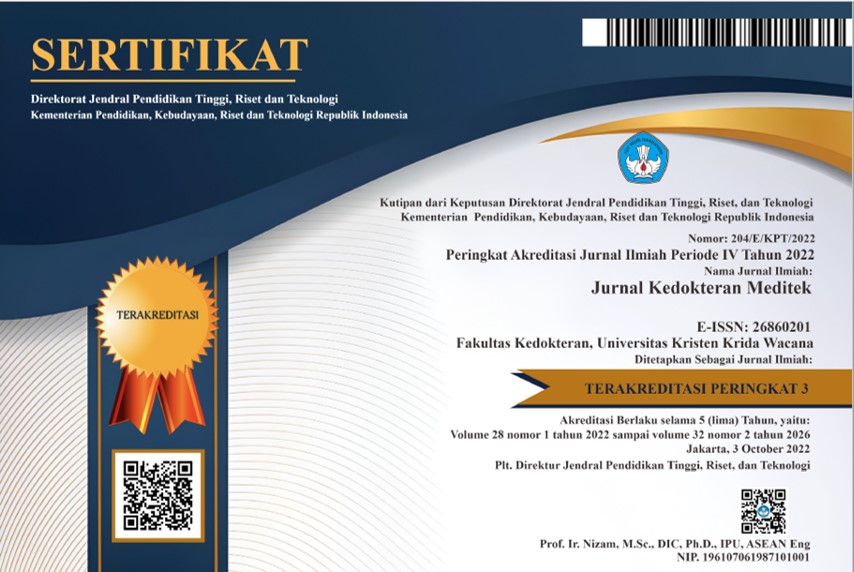Pendekatan Fenotipe dan Genotipe Sorbitol Fermentasi Shiga Toxin Strain Escherichia coli O157:H- untuk Diagnosis Mikrobiologi Hemorrhagic Colitis dan Hemolytic Uremic Syndrome
DOI:
https://doi.org/10.36452/jkdoktmeditek.v21i57.1166Abstract
Abstrak
Strain patogen Escherichia coli (E. coli) dapat menyebabkan gejala diare ringan sampai berat, infeksi saluran kemih, sepsis,  atau meningitis pada manusia. Patogenesis infeksi E. coli ditentukan berdasarkan pada kemampuan virulensi, interaksi bakteri pada mukosa usus, perbedaan serotipe antigen O dan H serta kondisi imun hospes. Shiga toxin (stx) yang dihasilkan oleh Escherichia coli O157:H7 sudah terbukti sebagai penyebab utama hemorrhagic colitis dan hemolytic uremic syndrome (HUS). Sorbitol Fermentasi Shiga Toxin Escherichia coli (SF STEC) O157:H- pertama kali ditemukan pada tahun 1988 sebagai penyebab HUS di Bavaria,  Jerman. Bakteri berhasil diisolasi dari feses pasien anak yang mengalami kefatalan akibat bakteri ini. Meningkatnya infeksi SF STEC O157:H-, etiologi HUS dan diare secara epidemiologis, kurang dipahami karena keterbatasan data dan perbedaan-perbedaan aspek epidemiologis infeksi yang disebabkan  SF STEC O157:H7-. Gabungan media seleksi untuk isolasi strain SF STEC O157:H-, pengembangan immunomagnetic separation (IMS) dapat menghasilkan sensitivitas dan spesifisitas prosedur diagnosis untuk meningkatkan ditemukannya isolat patogen dari spesimen klinik dan spesimen lingkungan secara optimal. Kata kunci: Sorbitol Fermentasi, Shiga Toxin Escherichia coli, O157:H-, Sorbitol Mac Conkey, diare, hemorrhagic colitis, hemolytic uremic syndrome. AbstractPathogenic strains of Escherichia coli (E. coli) can cause mild to severe diarrhea, urinary tract infections, sepsis or meningitis in human. The pathogenesis of E. coli infection is determined based on the ability of the virulence, interaction of bacteria in the intestinal mucosa, the difference serotypes O and H antigens and host immune conditions. Shiga toxin (stx) produced Escherichia coli O157: H7 has been proven to be the main cause hemorrhagic colitis and hemolytic uremic syndrome (HUS). Sorbitol fermentation Escherichia coli Shiga toxin (SF STEC) O157: H-, first discovered in 1988 as the cause of HUS in Bavaria Germany, bacteria were isolated from the feces of patients who experienced child fatalities due to these bacteria. Increased infection SF STEC O 157: H-, in the etiology of HUS and diarrhea in epidemiology, poorly understood because of data limitations and differences in the epidemiology of infections caused aspects of SF STEC O157: H7-. Combined selection media for the isolation of SF STEC strain O157: H-, immunomagnetic separation (IMS) development can generate sensitivity and specificity of diagnostic procedures to improve the discovery of pathogenic isolates from clinical specimens and environmental specimens optimally.
Â
Key words: Sorbitol Fermentasi, Shiga Toxin Escherichia coli, O157:H-, Sorbitol Mac Conkey, diare, hemorrhagic colitis, hemolytic uremic syndrome.Â

















